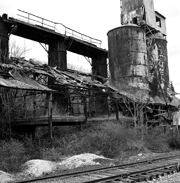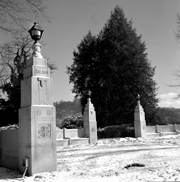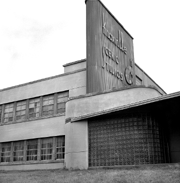![]()
 Double Takes
Double TakesConfident cities celebrate their oddities. Knoxville, for the most part, does not. When we don't hide our eccentricities, we take them for granted, ignore them, eventually forget they're there. But it might do us some good occasionally, to notice a few of the many things that makes Knoxville distinct from every other interstate hub in America. This photo feature is dedicated to considering just a few of Knoxville's many unusual sights.
text by Jack Neely, photographs by Aaron Jay
 Keith Ave. Sentry
Keith Ave. Sentry
This Greek warrior in traditional garb surveys Keith Avenue from his waterproof sentry box in his master's front yard. The flesh-and-blood resident of this address prefers to let the soldier speak for himself.
 Farragut Monument
Farragut Monument
The town of Farragut's only excuse for using the name is that it's not far from this spot, the riverside birthplace of Admiral David Glasgow Farragut. The site of the Farraguts' long-gone cabin is at the end of a one-lane dirt road off Northshore in Concord -- on private property, and strictly off limits to visitors. Ironically, this lonesome marker was dedicated here in 1900 with an extravagant public ceremony attended by national hero Admiral George Dewey, the D.A.R., and a whole flotilla of steamboats bearing the national press.
 Keyhole Door
Keyhole Door
Originally the townhouse residence of a local doctor, more recently home of the Knoxville Business College, 209 Church with its lopsided keyhole doorway (the address is part of the sculpture, in case you forget) is one of relatively few architectural anomalies remaining in downtown Knoxville and has been the backdrop for more than one aspiring Knoxville band's record-jacket photo.
 Meade's Quarry
Meade's Quarry
The old marble works in South Knoxville just past Island Home has been silent for years, but now grows trees in its silt-laden upper floors. It overlooks the old flooded quarry itself, now home to fat turtles, one of Knoxville's most beautiful--and dangerous--spots.
 Talahi
Talahi
Several concrete monuments, with a peculiar combination of Egyptian and Cherokee symbols, have long puzzled joggers along Cherokee Boulevard, who may not guess they're 70 years old. (This elaborate entryway at Cherokee at Talahi leads only to the riverbank.) They're the only remains of an idea whose time had not yet come: the planned community. Robert Foust, a visionary developer, pictured a neighborhood in harmony with nature and itself, where residents would not build fences between their yards. Sunhouse Fountain, Panther Fountain and Papoose Park were to be the public center of the community. Partly due to public skepticism, partly due to the crash of '29, the project was a dismal failure; the conventional neighborhood of Sequoyah Hills seeped in around the skeleton of Talahi. Discouraged, Foust committed suicide.
 Underground Gay Street
Underground Gay Street
This window which once looked out on Gay Street hasn't seen the morning sun since before the first radio broadcast. The last time its sash kept out a spring rain, Doughboys were crowding the train station a block away, home from whooping the Kaiser. In 1919, the 100 block of Gay Street, which had been a dangerously steep hill up from the Southern terminal, was raised to level it, and filled in with thousands of tons of dirt. But long-rumored Underground Knoxville is accessible only via a few basements and is really no more than a series of dark, cramped private patios onto a dead world.
 The Airplane
The Airplane
Originally a filling station, the Clinton Highway "Airplane" was the pride of builder David McKinley Johnson, an innovative filling-station architect hereabouts. Built around 1934, it bears a passing resemblance to Lindbergh's Spirit of St. Louis. It has succeeded in convincing more than one gawker that it's actually a real airplane, converted to ground use.
 KUB Water Works
KUB Water Works
This double-take usually occurs from the water. Boaters on the river just above downtown view these battlements peering above the foliage, return to shore and say, breathlessly, "Have you seen that old castle on the shore?" Those unfamiliar with Civil War fortifications are routinely convinced it's a Confederate castle, with posts for Confederate archers. However, one of Knoxville's most impressive and least seen buildings is known modestly as the Williams Creek Pumping Station, or later, as the Mark B. Whitaker Treatment Plant. Since its completion in 1927, it has been Knoxville's primary water supplier, pumping a reported 34 million gallons of water daily.
 Knoxville Scenic Studios
Knoxville Scenic Studios
Many see it every day, commuting from South Knoxville along Maryville Pike. Those who don't see it daily--and some who do--look twice at this large, unexpected Art Moderne structure, now vacant and surrounded in the summertime with mimosa and kudzu. Was it an oversized portrait studio? An art school? A TV studio? In fact, for decades this was an unusual sort of factory, housing busy artisans who specialized in manufacturing theater backdrops and elaborate curtains for theaters and movie houses across the continent, from Canada to Texas. The "tower" was built expressly for hanging curtains as they were being put together. Knoxville architect Jim Mitchell designed the building in 1946 to suit his clients who wanted to seem both very modern and very glamorous. For years, Knoxville Scenic Studios succeeded at both, with annual revenue in the neighborhood of $1 million (that's in early '50s dollars). The market for glamorous theater furnishings dwindled over the years, but KSS still occupied the concrete building as late as 1992. The lobby was said to be something to behold.